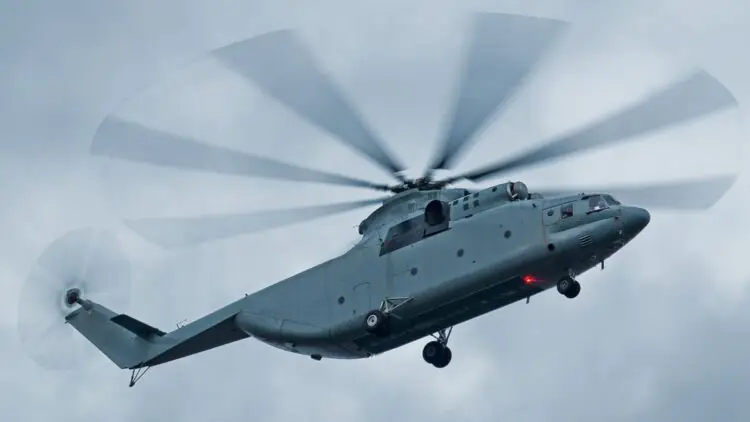It all started in the early 1970s when Soviet leadership set a goal to develop a helicopter capable of transporting 20 tons of cargo over a distance of up to 400 kilometers. The existing Mi-6 at the time could carry no more than 8 tons, or up to 11.5 tons at the cost of reduced fuel capacity, which significantly limited its range. Initially, the Mi-26 was envisioned as an upgraded version of the Mi-6, but it soon became clear that an entirely new aircraft was needed. One of the key requirements was also to expand the internal cargo bay, making a simple redesign insufficient.

Read also:
- Ukrainian “Trembita” Cruise Missile Unveiled at Exhibition for the First Time
- Photos of a Ukrainian F-16 After Returning from a Combat Mission Appear Online
TABLE OF CONTENT:
Creation of Mi-26
Building on the operational experience of the Mi-6 and Mi-10 (which was designed to be as unified with the Mi-6 as possible), an initial design for the new helicopter was completed by 1972. A refined full-scale model was presented to the state commission in 1975, and by 1977, the first flight-ready Mi-26 was handed over for testing.

The Mi-26 turned out to be an impressive machine. Despite having a similar weight to the Mi-6 – whose tail rotor blades were even partially made of wood – the new helicopter could accommodate twice the cargo volume. This was a direct result of one of the key design requirements: the ability to transport modern and future weapon systems for motorized rifle divisions. Additionally, the Mi-26 needed to operate at altitudes of 1,500–2,000 meters for mountain operations. And, of course, it delivered on the promised 20-ton payload capacity.

Another notable detail was the introduction of a new eight-blade composite main rotor, which was 40% lighter than the five-blade metal rotor of the Mi-6. A major design shift – and a significant challenge – was the transmission of torque from the two Zaporizhzhia-built D-136 engines to the main rotor. Instead of the planetary gearbox used in the Mi-6, the Mi-26 featured a three-stage, multi-flow gearbox. This change resulted in a 1.5-fold increase in torque transfer to the rotor, from approximately 15,500 Nm in the Mi-6 to around 21,500 Nm in the Mi-26.
Read also:
- Ukrainian Company Ukrspecsystems Unveils Shark-M Drone: Details of New Release
- Top 10 Most Important Known Military Satellites
Mi-26 engine
The powerplant for the Mi-26 was developed by the Zaporizhzhia-based “Progress” design bureau. They adapted the existing D-36 engine – originally used in the An-72 and An-74 aircraft – into a turboshaft version specifically for helicopters. This modified engine, designated D-136, delivered 11,500 horsepower in takeoff mode. According to the design specifications, a single engine was capable of keeping the helicopter airborne in the event of a failure of the second engine. However, the operational manual permits this emergency mode for a maximum of five minutes.

Increase in the number of aviation incidents with Mi-26
Now for the critical part. Over the past 20 years, there have been at least six aviation incidents involving the Mi-26. Except for the first one, all followed the same pattern: approach for landing while carrying cargo, either in the cabin or on an external sling. The outcome – structural failure of the tail boom. Photos from these incidents often show the helicopter resting on its right side, with the detached tail boom lying separately. One such case occurred on April 25, 2020, when Mi-26 RA-06268 attempted a landing on a single engine in Yamal.

Even with a well-developed landing gear system featuring shock absorbers, the impact forces during landing are not sufficiently mitigated to prevent the tail boom from separating. This failure occurs even within the allowable overload limits. Another photo of RA-06268 illustrates this issue:

Read also:
- Can the U.S. Plant Its Flag on Mars?
-
Ukrainian Company Sine.Engineering Develops New System to Counter Russian Electronic Warfare
What are the causes of Mi-26 accidents?
I found this table, which lists the aircraft and their factory series. All the production dates fall within a span of nearly three years, from April 1989 to February 1992. During this period, a different aluminum alloy was used for the structural framework, specifically the 01420 alloy.
This alloy is inferior to the design-spec alloy, meaning it cannot withstand the intended load requirements. Additionally, external factors, such as impacts from the main rotor hitting the tail boom and the stress of transporting loads on the external sling, further degrade its performance. In the early 2000s, numerous studies were conducted, including:
- Load parameter calculations
- Distribution of cracks in the stringers
- Measurement of the fatigue crack growth rate
In addition, new flight instructions were written for all this.

However, due to the varying conditions in which helicopters are operated and repaired – some in makeshift setups, others at factory-level facilities – risk groups emerged in the previous table. Adding to the complexity was the fact that cracks in the structure are almost impossible to detect in the early stages during regular operation. This is because inspecting these cracks requires accessing the beginning of the tail boom, which can only be done with partial disassembly of the structure.
It was later discovered, for instance, that aircraft 06121, after an extended service life, flew only 143 hours and 18 hours after the last inspection (about three flight shifts). The aircraft that crashed in Yamal, RA-06268, was found during the investigation to have not undergone any repairs for 20 years. Looking closely at the table, it becomes apparent that the frequency of incidents only increased between 2018 and 2020.
The story of the decline of the Mi-26
As of 2020, only 20 Mi-26 helicopters were in operation in Russia, which is less than 30% of the total fleet. The situation remains unclear, as there are no other heavy helicopters in Russia’s inventory. The Mi-6 was retired in 2002 due to a lack of qualified personnel to maintain it, as well as the depletion of spare wooden tail rotors (this is not a joke).
After 1992, the 01420 alloy was no longer used for the structural framework. During this period, approximately 40 Mi-26 helicopters were produced, most of which were exported. A list of these can be found here.
Mi-26 operators include: Algeria, Jordan, Venezuela, and China. Additionally, a couple of helicopters are in service with the Russian Ministry of Emergency Situations.

Unlike the military Mi-24 helicopter, where the tail boom can be replaced, the Mi-26’s tail boom is non-detachable, meaning it essentially requires a complete rebuild of the aircraft. As a result, of the 30 Mi-26 helicopters, the Russians have already lost one in every six.
Read also:
And what about Ukraine?
After the dissolution of the USSR, Ukraine inherited 92 Mi-26 helicopters. By 1999, all of Ukraine’s Mi-26s had reached the end of their calendar service life. However, due to a lack of funds for extending their service, flights were discontinued.

Three helicopters were sold, but since the issue of restoring their airworthiness has not been resolved, these helicopters are also grounded.

This is the rather sad story of the large, serially produced Mi-26 cargo helicopter. Feel free to leave your thoughts, comments, and suggestions below. Until next time!
Read also:









